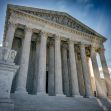On June 30, 2020, the U.S. Supreme Court ruled in Espinoza v. Montana Department of Revenue that Montana’s public-funded scholarship program for students to attend private schools cannot exclude religious schools.
“A state need not subsidize private education,” Chief Justice John Roberts wrote in the 5-4 majority opinion. “But once a state decides to do so, it cannot disqualify some private schools solely because they are religious.” He was joined by Justices Samuel Alito, Neil Gorsuch, Brett Kavanaugh, and Clarence Thomas.
The decision overturns a ruling made in the Montana Supreme Court, which had said that the Department of Revenue could not withhold aid from religious schools, but that the scholarship program itself violates Montana’s constitution. The court claimed that the state constitution “more broadly prohibits ‘any’ state aid to sectarian schools and draws a more stringent line” than federal law does.
Montana built the scholarship program in 2015 according to the state’s “Blaine amendment,” which stipulates that state funding cannot be used for religious-based education; the Department of Revenue defined this “no-aid” provision clearly as “Rule 1.” The program would provide income tax credits from the state to match donations to organizations that provide private school scholarships—as long as the schools were not sectarian, or religious, institutions.
However, three families eligible for the scholarship program argued that the provision discriminated against them unconstitutionally on the basis of religion. The First Amendment of the U.S. Constitution bars Congress from making any “law respecting an establishment of religion, or prohibiting the free exercise thereof.” Ultimately, the Supreme Court upheld the families’ position, ruling that the program’s “Rule 1” withheld public aid “solely because of the religious character of the school.”
Named for Congressman James G. Blaine, the original “Blaine Amendment” was proposed as part of the late-1800s push to delineate the separation of church and state in schools with a new Amendment to the U.S. Constitution. The bill did not make it past the Senate, even after sweeping the House of Representatives’ votes, but state governments subsequently wrote versions of it into their own constitutions. These “no-aid” restrictions were intended to fundamentally guarantee that the government and the churches would stay out of each other’s business; religious schools would not receive funding from the government, but they also would enjoy additional independence from government interference.
However, state laws cannot violate the U.S. Constitution, and this Espinoza ruling may foretell a downhill journey for standing Blaine amendments. The Court’s opinion emphasizes the freedom of religion guaranteed by the First Amendment, which prevents both the government from partaking in religious affairs and religious associations from overtaking or influencing government authority.
The Court said that striking the program down would “(put) the school to a choice between being religious or receiving government benefits,” thereby penalizing the free exercise of religion provided by the First Amendment’s Free Exercise Clause. Justice Thomas added that Montana’s program was not constructing any specific aid to fund religious institutions; therefore, he said, with Rule 1 excluded, it remains constitutional under the Establishment Clause (the First Amendment’s other religious freedom provision).
Thirty-eight U.S. states’ constitutions include Blaine amendments, some of which are incorporated into programs and benefits similar to Montana’s scholarship program. However, the Supreme Court has ruled in favor of government benefits being awarded to religious institutions if the funding is distributed without bias, a position solidified with Espinoza. The standard for this bias is extended broadly with the decision, which establishes a precedent that will subsequently question the validity of a multitude of state laws dictating religious institution exclusions.
The core dispute with the consequences of this case stems from the duality written into the freedom of religion. The government technically cannot direct tax funds for religious purposes; however, it also cannot discriminate against religious purposes to withhold government aid.
When the Montana Supreme Court struck the program down, it cited the difference between the U.S. Constitution and the state’s constitution, noting that the latter was written to regulate religious institutions’ state benefits more strictly. The idea that withholding aid to religious schools is discriminatory based on religion invokes the Fourteenth Amendment’s Equal Protection Clause; assessing laws with “rational basis scrutiny,” the court can determine whether or not the alleged discrimination is justified. Indeed, courts have ruled in various iterations of this issue over the years. Poverty and age have not qualified as legal discrimination classifications, but other categorizations such as immigration status and “wedlock status at birth” have qualified in the eyes of the courts. Religion-based bias, it appears, may warrant similar scrutiny.
Alito references another Supreme Court case from this current term - Ramos v. Louisiana - to support his concurrence with the majority opinion, citing “virulent prejudice against Catholic immigrants” and claiming that Montana’s public schools originated as an “anti-Catholic animus.” Such an interpretation reflects on the application of discrimination law and the federal government’s role to interfere with state laws regarding the separation of church and state.
“Not only is the (Supreme Court) wrong to decide this case at all, it decides it wrongly,” Justice Sonia Sotomayor wrote in dissent. With the tax benefits now nonexistent in Montana, the more liberal Justices did not believe in hearing the case at all, let alone overturning the lower court’s ruling. The U.S. has a pronounced history of separating church and state, but the Espinoza v. Montana decision is a significant commentary on what that entails.
The continued banishment of religious schools from the realm of public funding can either be
considered discriminatory and restrictive of religious freedom or, as Justice Stephen Breyer wrote, “compel(ling) a man to furnish contributions of money for the propagation of opinions which he disbelieves is sinful and tyrannical.” Which response is most warranted will unfold as this landmark decision begins to ripple across the country, blurring the once-distinct line between church and state.






